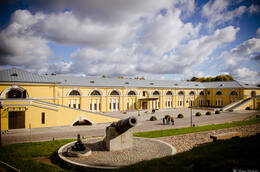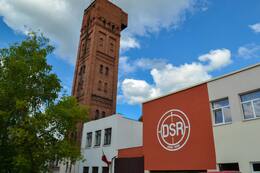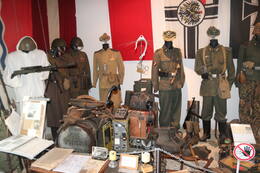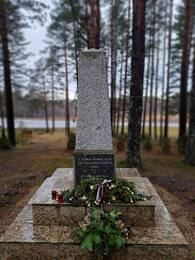Latgala – sritis prie Latvijos rytinės sienos
Diena 1.
120 km
Daugpilis – Aglona – Rušenica – Rezeknė
Praktinė informacija
- Maršrutas skirtas kaip vadovas – kaip optimaliai keliauti po regioną ar šalį, arba dvi šalis, siekiant pažinti jų karinį paveldą;
- Vairuotojas turi pats suplanuoti – kiek iš rekomenduojamų objektų ir vietų jis gali apžiūrėti per vieną dieną;
- Prieš kelionę reikėtų pasitikrinti lankytinų vietų (muziejų, kolekcijų, įtvirtinimų ir kt.) darbo laiką;
- Vietose, kur reikalinga išankstinė registracija (vietiniai gidai, privačios kolekcijos, kitos), apsilankymą būtina užsisakyti, nurodant datą ir laiką. Jei kelionė atšaukiama, apie tai reikia informuoti užregistruotas vietas;
- Apgyvendinimą būtina užsisakyti iš anksto. Vasaros sezonu apgyvendinimo paslaugos gali būti neprieinamos, ypač pajūryje. Kai kurios maitinimo įstaigos žiemos sezonu gali nedirbti;
- Kelionei rinkitės ne tik vasarą, bet ir kitus metų laikus;
- Latvijos, Lietuvos ir Estijos sienas keliais galima laisvai kirsti be apribojimų ir bet kuriuo paros metu. Vykstant iš vienos šalies į kitą, būtina su savimi turėti asmens tapatybės kortelę arba pasą;
- Apsilankykite turizmo informacijos centruose, kur galite gauti papildomos informacijos, brošiūrų ir žemėlapių;
- Norint aplankyti objektus, esančius Latvijos, Rusijos ir Baltarusijos pasienio režimo zonoje, reikalingas leidimas su laiko apribojimais. Daugiau informacijos rasite: https://www.rs.gov.lv/lv/pierobezas-joslas-rezims (LV, EN).
Lankytinos vietos
Daugpilio tvirtovė
Daugpilio tvirtovė – valstybinės reikšmės architektūros ir kultūros istorijos paminklas. Tai paskutinė pasaulyje pastatyta bastioninio tipo tvirtovė ir vienintelis Vidurio Europoje išlikęs XIX a. pirmosios pusės tvirtovės pavyzdys, išlikęs be didesnių pokyčių.
Tvirtovės statyba pradėta 1810 m., carinei Rusijai rengiantis Napoleono kariuomenės įsiveržimui, ir truko iki 1878 m. Dar nebaigus statybos, 1812 m., prie tvirtovės vyko rusų ir prancūzų karių mūšiai. Nors po Napoleono karų statybos buvo tęsiamos, jau tuomet tvirtovė ėmė prarasti savo karinę reikšmę.
Pirmojo pasaulinio karo metais (1915–1918) tvirtovė buvo Rusijos kariuomenės logistikos ir palaikymo bazė. 1918 m. vasarį ją užėmė vokiečių kariuomenė, o gruodį – bolševikai. 1920 m. sausį tvirtovę užėmė lenkų kariai, padėję Latvijos kariuomenei išlaisvinti Latgalą nuo bolševikų. Tarpukariu, 1920–1940 m., tvirtovėje buvo dislokuota Latvijos kariuomenės 4-oji Žiemgalos divizija.
1940 m. okupavus Latviją, tvirtovėje įsikūrė Raudonosios armijos daliniai, o vokiečių okupacijos metais čia buvo karo belaisvių stovykla „Stalag-340“. Po 1944 m. sovietų sugrįžimo tvirtovė vėl atiteko sovietinei armijai. Latvija tvirtovę atgavo tik 1993 m., kai iš jos pasitraukė Rusijos kariuomenė.
Daugpilio šratų gamykla
Daugpilio šratų gamykla, įkurta 1885 m., yra seniausia šaudmenų gamykla Šiaurės Europoje. Tai vienintelė tokio tipo gamykla Baltijos šalyse ir vienas seniausių pramoninio paveldo objektų Latvijoje. Joje veikia vienintelis Europoje švino šratų liejimo bokštas.
Gamykla jau daugiau nei šimtmetį gamina aukštos kokybės medžioklinius šratus ir šią veiklą tęsia iki šiol. Joje išlikę XIX a. įrenginiai ir konstrukcijos, sumontuoti Pirmojo ir Antrojo pasaulinio karų metu. Šiuo metu šratų gamybai naudojama ir moderni įranga.
Lankytojai gali apžiūrėti istorinę ekspoziciją, šratų liejimo cechą ir užlipti į unikalų 31,5 m aukščio bokštą, po kuriuo yra 13,5 m gylio aušinimo šulinys. Gamykla yra populiari turistų lankoma vieta, pritraukianti tiek vietinius, tiek užsienio lankytojus, kurie gali susipažinti su XIX a. pramonės paveldu ir pamatyti, kaip veikia senoji technika. Apžiūrėję gamyklą lankytojai gali išbandyti joje gaminamus šratus gamyklos šaudykloje.
WW2 – Antrojo pasaulinio karo ekspozicija Agluonoje
Antrojo pasaulinio karo ekspozicija Agluonoje – dar vadinama Karo muziejumi – įkurta 2008 m. ir yra viena didžiausių bei įdomiausių tokio pobūdžio ekspozicijų Latvijoje. Kolekcija nuolat papildoma naujai įsigytais eksponatais, karo dalyvių ir karo meto kartos žmonių pasakojimais.
Muziejaus fondo pagrindą sudaro per Antrąjį pasaulinį karą naudoti ginklai, ekipuotė, amunicija ir uniformos. Tai pat galima pamatyti įvairius buities reikmenis, lėktuvų nuolaužas ir kitus eksponatus. Vienas vertingiausių ir išskirtiniausių eksponatų yra karo lauko pašto laiškai tarp oberleitenanto Augusto ir jo mylimosios Martos. Penkerius karo metus trukęs dviejų mylinčių žmonių susirašinėjimas baigėsi laimingai. Ekspozicijos fone rodomos karo meto kronikos. Ekspozicija nėra politizuota – joje vienodai pristatomos abi kariaujančios pusės, todėl lankytojai turi galimybę neskirstydami į gerą ir blogą, lengvai suprasti ekspoziciją.
Latvijos laisvės kovų paminklas 3-iojo Jelgavos pėstininkų pulko mūšių vietoje
Paminklas 3-iojo Jelgavos pėstininkų pulko 1920 m. sausio 16 d. laisvės kovai Latgaloje. Su užrašu: „3-iojo Jelgavos pėstininkų pulko mūšių, pergalingo žygio per Latgalą vieta. 1920.16.I. Mes atnešėme Latvijai saulę, laisvę ir nepriklausomybę“.
Paminklas atidengtas 1936 m. Rugpjūčio 16 d. jį pašventino generolas Žanis Bachas (1885–1941), o jį pašventino pastorius Adamas Vizulis (1891–1970). Paminklo projekto autorius buvo inžinierius Zilēvičs.
Latvijos Nepriklausomybės karo (1918–1920 m.) operacija, skirta Latgalai išlaisvinti, prasidėjo 1920 m. sausio 3 d. Iki sausio vidurio Latvijos ir Lenkijos armijos išlaisvino Daugpilį ir didžiąją dalį pietinės Latgalos iki Dagdos–Indros linijos nuo bolševikų pajėgų, užgrobusių valdžią Rusijoje. Sausio 9 d. Latvijos armija pradėjo puolimą Šiaurės Latgaloje, sparčiai žygiuodama Karsavos ir Pitalovos stočių link.
Tarp dviejų puolimo krypčių liko bolševikų kontroliuojama teritorija aplink Varaklianus, Vilanius ir Rėzeknę. Sausio 20 d. Latvijos armijos daliniai pradėjo Rėzeknės išvadavimo operaciją. Rėzeknė buvo išlaisvinta sausio 21 d. Latvijos armija, per visą Rytų fronto plotą, iki sausio pabaigos pasiekė latvių gyvenamų žemių sieną. Jau vasario 1 d. Sovietų Rusija pasirašė paliaubų sutartį su Latvija.
Pergale Latgalos mūšiuose buvo užtikrinta Latvijos rytinė siena ir atsirado galimybė prijungti Latviją prie Latvijos. Latvijos kariuomenė galutinai suvienijo Latviją ir paskelbė nepriklausomybę 1920 m.
Paminklas, datuotas 1920.16.I., skirtas atminti akimirką, kai 3-iasis Jelgavos pėstininkų pulkas užėmė pradines pozicijas prieš Rėzeknės išvadavimo operaciją.
Vietos pavalgyti
- Daugpilyje žr. visitdaugavpils.lv
- Terasa „Eglė“ ir kavinė „Somersēta“ Aglonoje
- Rezeknėje žr . visit.rezekne.lv
Vietos apsistoti
- Daugpilyje žr. visitdaugavpil s
- Informacijos apie Agloną ieškokite latgale.travel
- Rezeknėje žr . visit.rezekne.lv







